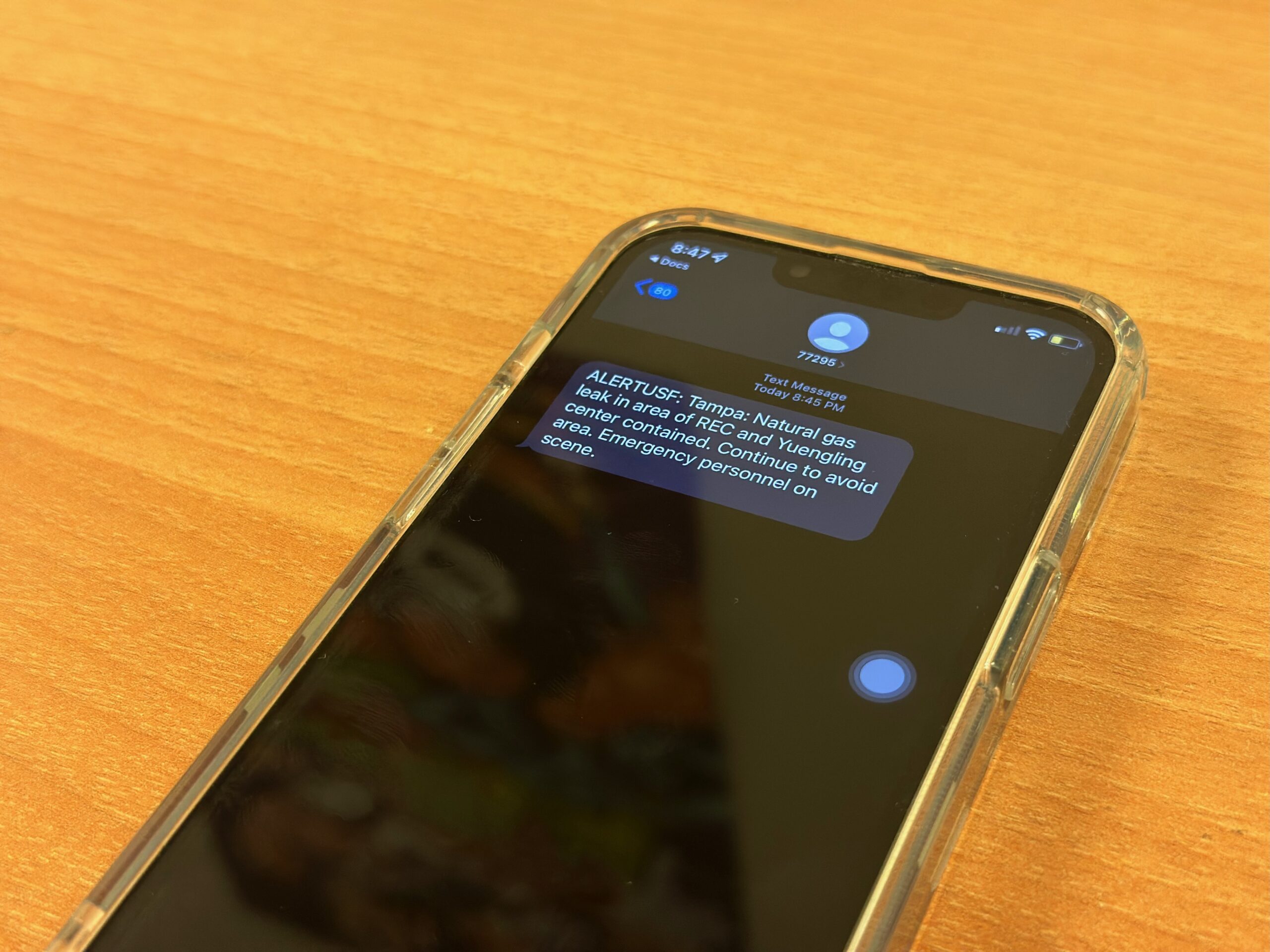ALERT: USF will soon automatically notify you when danger is on campus

Imagine it: An armed person arrives on campus. Those on campus are told to take protective measures. However, others who never signed up for USF’s Emergency Notification System (ENS) go on campus, oblivious to potential danger.
This scenario wasn’t fictional for some students – it was a frightening reality.
Two vehicles entered LeRoy Collins parking garage on Jan. 4 following a road rage incident, according to a media release from UP. One driver pointed a gun at the other driver before leaving, according to the release.
Related: USF police arrest man involved in on-campus road rage incident
Situations like these are why Grant Gundle, Emergency Management director, said the university is switching to an “opt-out” system this year, meaning all students and faculty will be automatically enrolled to receive alerts.
USF currently has an “opt-in” system, where students are required to make the choice to sign up for alerts manually.
What is an opt-out system?
Students, faculty and staff would be signed up for emergency alert notifications automatically whenever they are registered with USF as a new hire or student. If someone wanted to stop receiving alerts, they would have to manually “opt-out.”
Current students and faculty members will also be signed up through contact information already in USF’s system.
Gundle said work is still being done to figure out how employees affiliated with campus partners will be included. Although Gundle said Moffitt employees can register for the alert system via their employee email, Purvish Trivedi, a data analyst at the Moffitt Cancer Center at the USF Tampa campus, said he did not sign up since he already receives alerts through Moffitt directly.
Trivedi, 27, said most people were coming into work or stepping outside for fresh air during the armed person alert on Jan. 4, so the communication from Moffitt was helpful.
Why change to an opt-out system?
“Reach.”
That’s what university spokesman Aaron Nichols said was a driving factor in making the switch to an opt-out system.
Students can hear about the alert system at orientation, at BullMarket or through flyers on campus, but Nichols said these aren’t surefire ways to ensure students take action and don’t procrastinate signing up.
“The ENS is about saving lives,” Nichols said. “If we can capture everyone at once without having to take those extra steps to get them to sign up, that improves the safety of the USF community.”
Douglas Bohannon, a junior English major, said he hasn’t signed up for the ENS. However, he said he wished he was automatically enrolled to receive alerts given how frequently he drives by or on campus.
Bohannon and his wife were driving on campus looking for his classes before the first day of school a couple days before the armed person alert was sent out, he said.
When will it be implemented?
The system will be implemented this year, but Gundle said an exact date is unknown.
Gundle said USF has been wanting to make the conversion for a couple of years. More time is needed to ensure the update will be effectively promoted, legal guidelines are followed and the technology working correctly so people have the option to opt-out.
How does the alert system work?
Chris Daniel, University Police (UP) chief, said when officers respond to a situation that requires an alert to be sent out, including things like an armed person or a chemical waste spill, they send an initial alert out that warns those on campus about what is happening.
Related: Natural gas leak contained near Yuengling Center, REC
From there, UP gets in contact with Emergency Management and works with them to provide updates “every 10-15 minutes” depending on the situation, Daniel said.
Alerts can take many forms, including text messages, desktop pop-ups on technology “maintained by USF IT” and indoor notifications such as televisions in the Marshall Student Center.
An alert will only be sent out when an officer arrives and confirms the issue is happening – not when an eyewitness reports it – to avoid unnecessary panic, Daniel said.
Gundle said about 47,000 people are signed up for USF’s alert system. You can sign up for text message alerts by clicking here and following the instructions listed.
Does the USF community approve?
When Bohannon was asked to give his thoughts on the new opt-out system, his response was straightforward: “I had no idea the emergency alert notification existed.”
This is one reason he thinks the switch will be beneficial to students – so people like him can feel safer on campus.
Trivedi, who immigrated to the U.S. from India, said the switch will benefit international students that come to campus and need time to adjust to university policies.
“It takes a couple of months to get used to the new university systems because back in my home country, the universities work in a different way,” Trivedi said.
Student Body President Cesar Esmeraldi, who is from Brazil, said many of the systems and policies in the U.S. are new concepts to international students.
“A lot of our students come in all by themselves,” Esmeraldi said. “So to know that the university has your back and is communicating with you through good and hard times…it makes you feel at home.”
Bohannon said the change is a long time coming.
“I feel like it was a bit irresponsible that the call was decided, ‘Hey, you have to tell us if you want to know,’” he said.







